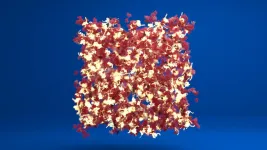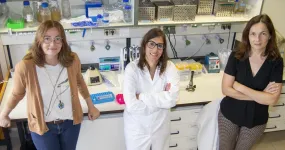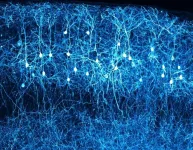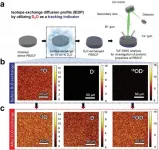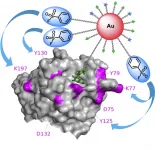(Press-News.org) BOSTON -- As we age, our brains typically undergo a slow process of atrophy, causing less robust communication between various brain regions, which leads to declining memory and other cognitive functions. But a rare group of older individuals called "superagers" have been shown to learn and recall novel information as well as a 25-year-old. Investigators from Massachusetts General Hospital (MGH) have now identified the brain activity that underlies superagers' superior memory. "This is the first time we have images of the function of superagers' brains as they actively learn and remember new information," says Alexandra Touroutoglou, PhD, director of Imaging Operations at MGH's Frontotemporal Disorders Unit and senior author of the paper published in Cerebral Cortex.
In 2016, Touroutoglou and her fellow researchers identified a group of adults older than 65 with remarkable performance on memory tests. The superagers are participants in an ongoing longitudinal study of aging at MGH led by Bradford Dickerson, MD, director of the Frontotemporal Disorders Unit at MGH, and Lisa Feldman Barrett, PhD, a research scientist in Psychiatry at MGH. "Using MRI, we found that the structure of superagers' brains and the connectivity of their neural networks more closely resemble the brains of young adults; superagers had avoided the brain atrophy typically seen in older adults," says Touroutoglou.
In the new study, the investigators gave 40 adults with a mean age of 67 a very challenging memory test while their brains were imaged using functional magnetic resonance imaging (fMRI), which, unlike typical MRI, shows the activity of different brain areas during tasks. Forty-one young adults (mean age of 25) also took the same memory test while their brains were imaged. The participants first viewed 80 pictures of faces or scenes that were each paired with an adjective, such as a cityscape paired with the word "industrial" or a male face paired with the word "average." Their first task was to determine whether the word matched the image, a process called encoding. After 10 minutes, participants were presented with the 80 image-word pairs they had just learned, an additional 40 pairs of new words and images, and 40 rearranged pairs consisting of words and images they had previously seen. Their second task was to recall whether they had previously seen each specific word-picture pair, or whether they were looking at a new or rearranged pair.
While the participants were in the scanner, the researchers paid close attention to the visual cortex, which is the area of the brain that processes what you see and is particularly sensitive to aging. "In the visual cortex, there are populations of neurons that are selectively involved in processing different categories of images, such as faces, houses or scenes," says lead author Yuta Katsumi, PhD, a postdoctoral fellow in Psychiatry at MGH. "This selective function of each group of neurons makes them more efficient at processing what you see and creating a distinct memory of those images, which can then easily be retrieved."
During aging, this selectivity, called neural differentiation, diminishes and the group of neurons that once responded primarily to faces now activates for other images. The brain now has difficulty creating unique neural activation patterns for different types of images, which means it is making less distinctive mental representations of what the person is seeing. That's one reason older individuals have trouble remembering when they may have seen a television show, read an article, or eaten a specific meal.
But in the fMRI study, the superagers' memory performance was indistinguishable from the 25-year-olds', and their brains' visual cortex maintained youthful activity patterns. "The superagers had maintained the same high level of neural differentiation, or selectivity, as a young adult," says Katsumi. "Their brains enabled them to create distinct representations of the different categories of visual information so that they could accurately remember the image-word pairs."
An important question that researchers still must answer is whether "superagers' brains were always more efficient than their peers, or whether, over time, they developed mechanisms to compensate for the decline of the aging brain," says Touroutoglou.
Previous studies have shown that training can increase the selectivity of brain regions, which may be a potential intervention to delay or prevent the decline in neural differentiation in normal aging adults and make their brains more like those of superagers. Currently the researchers are conducting a clinical trial to evaluate whether noninvasive electromagnetic stimulation, which delivers an electrical current to targeted areas of the brain, can improve memory in older adults. The researchers also plan to study different brain regions to further understand how superagers learn and remember, and they will examine lifestyle and other factors that might contribute to superagers' amazing memory.
INFORMATION:
Major funding for this study was provided by the National Institute on Aging.
Touroutoglou is an assistant professor of Neurology at Harvard Medical School (HMS). Dickerson is professor of Neurology at HMS. Barrett is distinguished professor of Psychology at Northeastern University. The other co-author is Joseph Andreano, PhD, an investigator in the Department of Psychiatry at MGH and an instructor of Psychiatry at HMS.
About the Massachusetts General Hospital
Massachusetts General Hospital, founded in 1811, is the original and largest teaching hospital of Harvard Medical School. The Mass General Research Institute conducts the largest hospital-based research program in the nation, with annual research operations of more than $1 billion and comprises more than 9,500 researchers working across more than 30 institutes, centers and departments. In August 2020, Mass General was named #6 in the U.S. News & World Report list of "America's Best Hospitals."
Scientists at the University of Leeds have developed an approach that could help in the design of a new generation of synthetic biomaterials made from proteins.
The biomaterials could eventually have applications in joint repair or wound healing as well as other fields of healthcare and food production.
But one of the fundamental challenges is to control and fine tune the way protein building blocks assemble into complex protein networks that form the basis of biomaterials.
Scientists at Leeds are investigating how changes to the structure and mechanics of individual protein building blocks - changes at the nanoscale - can alter the structure and mechanics of the biomaterial ...
Two model studies document the probability of climate tipping in Earth subsystems. The findings support the urgency of restricting CO2 emissions as abrupt climate changes might be less predictable and more widespread in the climate system than anticipated. The work is part of the European TiPES project, coordinated by the University of Copenhagen, Denmark but was conducted by Professor Michael Ghil, Ecole Normale Supérieure, Paris, France and coauthours from The Royal Meteorological Institute of Belgium and Parthenope University of Naples, Italy.
Tipping could be imminent
It is often assumed climate change will proceed gradually as we increase the amounts of CO2 in ...
Streptococcus pneumoniae is a major human pathogen and a leading cause of several infectious diseases including pneumonia, the third-leading cause of death in Portugal. In Europe, S. pneumoniae is the most common cause of community-acquired bacterial pneumonia in adults. Still, very little is known about its colonization within this age group. A team of researchers from ITQB NOVA has now taken a crucial step to clarify the dynamics of carriage of this bacterium in adults.
This bacterium, also known as pneumococcus, can asymptomatically colonize the human upper respiratory tract. Colonization not only precedes diseases but is also essential for transmission. Even ...
In 2011, scientists confirmed a suspicion: There was a split in the local cosmos. Samples of the solar wind brought back to Earth by the Genesis mission definitively determined oxygen isotopes in the sun differ from those found on Earth, the moon and the other planets and satellites in the solar system.
Early in the solar system's history, material that would later coalesce into planets had been hit with a hefty dose of ultraviolet light, which can explain this difference. Where did it come from? Two theories emerged: Either the ultraviolet light came from our then-young sun, or it came from a large nearby star in the sun's stellar nursery.
Now, researchers from the lab of Ryan Ogliore, assistant professor of physics in Arts ...
The neocortex is a layered structure of the brain in which neurons are arranged parallel to each other. This organization is critical for healthy brain function. A team of researchers from Charité - Universitätsmedizin Berlin have uncovered two key processes that direct this organization. Reporting in Science Advances*, the researchers identify one crucial factor which ensures the timely movement of neurons into their destined layer and, subsequently, their final parallel orientation within this space.
The neocortex is the outer region of the brain. It is responsible for cognitive functions such as language, decision-making, and ...
A research team, led by Professor Guntae Kim in the School of Energy and Chemical Engineering at UNIST has introduced an innovative way to quantify proton kinetic properties of triple (H+/O2?/e?) conducting oxides (TCOs) being a significant indicator for characterizing the electrochemical behavior of proton and the mechanism of electrode reactions.
Layered perovskites have recently received much attention as they have been regarded as promising cathode materials for protonic ceramic fuel cells (PCFCs) that use proton conducting oxide (PCO) as an electrolyte. Therefore, quantitative characterization of the proton kinetics in TCO can be an important indicator providing a scientific ...
Psychologists from UNSW Sydney have developed a new face identification ability test that will help find facial recognition experts for a variety of police and government agencies, including contract tracing.
The Glasgow Face Matching Test 2 [GFMT2] targets high-performing facial recognition individuals known as super-recognisers, who have an extraordinary ability to memorise and recall faces.
The type of professional roles that involve face identification and that could benefit from the test include visa processors, passport issuers, border control officers, ...
Cells play a precise game of telephone, sending messages to each other that trigger actions further on. With clear signaling, the cells achieve their goals. In disease, however, the signals break up and result in confused messaging and unintended consequences. To help parse out these signals and how they function in health -- and go awry in disease -- scientists tag proteins with labels they can follow as the proteins interact with the molecular world around them.
The challenge is figuring out which proteins to label in the first place. Now, a team led by researchers from Tokyo University of Agriculture and Technology (TUAT) has developed a new approach to identifying and tagging the specific proteins. They published their results on June 1 in Angewandte ...
AUSTIN, Texas -- A diagnostic tool called the MasSpec Pen has been tested for the first time in pancreatic cancer patients during surgery. The device is shown to accurately identify tissues and surgical margins directly in patients and differentiate healthy and cancerous tissue from banked pancreas samples. At about 15 seconds per analysis, the method is more than 100 times as fast as the current gold standard diagnostic, Frozen Section Analysis. The ability to accurately identify margins between healthy and cancerous tissue in pancreatic cancer surgeries can give patients the greatest chance of survival.
The results, by a team from ...
TORONTO, July 6, 2021 - What's stressing out bumblebees? To find out, York University scientists used next-generation sequencing to look deep inside bumblebees for evidence of pesticide exposure, including neonicotinoids, as well as pathogens, and found both.
Using a conservation genomic approach - an emerging field of study that could radically change the way bee health is assessed - the researchers studied Bombus terricola or the yellow-banded bumblebee, a native to North America, in agricultural and non-agricultural areas. This new technique allows scientists to probe for invisible stressors affecting bees.
Like many pollinators, the yellow-banded bumblebee ...
